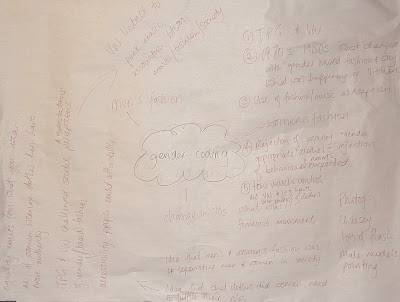Quote:From the 1970s onwards, and particularly since the 1980s predominant fashion designers such as Jean Paul Gautier and Vivienne Westwood have explored the persistance of gender coding conventions and stereotypes through their designs. In most contexts nonconformity to gender roles through dress tends to signal lack of conformity in a broader sense.
Brainstorm:

The Key Ideas that we took from this quote were:
1. Jean Paul Gautier and Vivienne Westwood
2. What changed the notion of 'gender-based' fashion and why? What was happening in society - eg, Vietnam.
3. Use of music/fashion as escapism/rejection of societal norms.
4. Rejection of wearing 'gender-appropriate' clothes = rejection of behavioural norms.
5. How much control did Gautier and Westwood have over the photography/representation of their clothes.
Reflection on Lesson:
This was an interesting lesson! Although we literally just met the two fashion students (Sophie and Emma... i think!) we all worked really well together.
What was interesting was when the fashion students brought us a book on Vivienne Westwood showing us an photograph which was a self portrait of Vivienne. As photographers, the first thing we noticed was the hideous backdrop of 'clouds' not even noticing so much what she was wearing, whereas the fashion students told us they never would've even noticed that it was a backdrop in their life because they were so focused on the fashion! Perfect example of how we can help each other out with our differing areas of knowledge. Also shows you how our eyes are trained to see (perception), and what we, as students studying different subjects, tend to focus on or percieve first.
Gruen Transfer
One more thing, really enjoyed the Gruen Transfer! Tried to find Episode 1 Set 3 so I could add it as a link but I coudln't find that particular episode on you tube or the ABC website. Anyway I had never seen this show. Very informative and pokes fun at the effect of advertising. Relating it to fashion and our quote, yes, appearance and popular culture, epsecially TV advertising, have an enormous effect on societal norms and sub cultures. Both consumers and the media are interrelating determinants - media influences the society, the society influences the media.
 General
General

